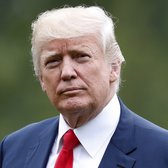President Donald Trump signed an executive order Jan. 28 that will restrict some of the lobbying White House officials can do after they leave his team.
Like most presidential crackdowns on ethics, it has caveats.
During the campaign, Trump pledged to reinstitute a five-year ban on executive branch officials lobbying the government after they leave office. He's also called on Congress to pass a five-year ban on lobbying by former members of Congress and their staff.
In the past, he said he'd rather Congress pass the bans into law to assure they will stick, but that's not the route he's taken with White House officials.
This lobbying ban lasts longer than the two-year threshold set by former President Barack Obama in 2009, but still doesn't completely satisfy Trump's original promise for a few reasons.
First, Trump's ban doesn't apply to congressional officials.
Currently, congressional officials are still beholden to the Honest Leadership and Open Government Act of 2007, which dictates a two-year cooling off period for senators, and a one-year period for representatives lobbying their formal office or committee. If Trump wants to change the lobbying rules for congressional officials he'll need to convince Congress to pass a law that overrides or amends the act.
Until then, part of Trump's campaign promise is still in limbo.
Second, the order only bans White House officials from lobbying their former agency, not from becoming lobbyists. The exact wording of Trump's promise specifies that the five-year ban be placed on "all executive branch officials lobbying the government."
Walter Olson, a senior fellow at the libertarian Cato Institute, said it's possible Trump's administration is just trying to cover the biggest problem: people going back to lobby their former colleagues to take advantage of their inside knowledge.
In addition to untouched congressional rules and the agency-only ban, there's also ongoing discussion on whether the definition of "lobbying activities," as defined by Section 2(n) of federal administrative code, carves out exceptions for the type of lobbying that can be done.
Most of the definition of "lobbying activities" is similar to language used in other lobbying legislation, but the exemption for agency proceedings (i.e "any agency process for rulemaking, adjudication, or licensing") is still being examined.
"There is on-going discussion in the legal community as to whether this provision will create a loophole or is justified because these administrative proceedings are governed by the Administrative Procedure Act," Meredith McGhee, the policy director at the Campaign Legal Center said.
Another potential issue is more lobbying in the shadows — when former government officials lobby, but do so without meeting the definition of a lobbyist. (They might be called strategic advisers, for example.)
Trump's executive order carries over the strict definition of lobbying as defined in the Lobbying Disclosure Act.
The future of this rating will depend on if Trump follows through on his promise for congressional officials and whether the language of the order creates lobbying loopholes.
As it stands now, this order only restricts some of the lobbying executive branch officials can do, and accomplishes substantially less than Trump's original promise to enact a five-year ban on lobbying, by only restricting White House officials from lobbying their former agency. He also signed an executive order instead of getting Congress to pass it into law.
We rate this promise Compromise for now.


